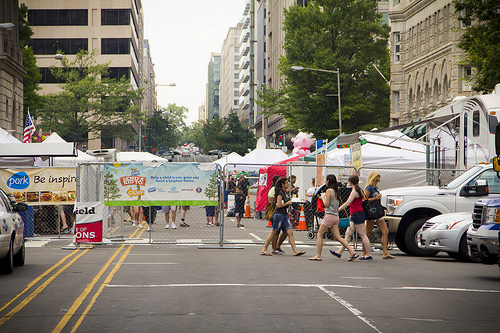Barbecue Battle fences cut the public off downtown
Most events on the National Mall or Pennsylvania Avenue have an open and inviting atmosphere, helping make DC a great place to live or visit. The annual Barbeque Battle, however, creates a fenced enclosure on Pennsylvania Avenue that makes downtown DC very difficult for pedestrians and cyclists to navigate.
This year’s enclosure fenced off 5 blocks as well as side-streets, forcing pedestrians on up to a 20-minute detour in place of what should have been a 30-second walk across the street from the Old Post Office.
An entrance fee of $15 precluded people from crossing. Worse, it also closed parts of the side streets, which further increased the walking time for those who thought they could just follow the fence line along Pennsylvania Avenue.
This is one of many special events that take place near the Mall that involve closing roads. Most events like races only require closing roads for a short period of time, and detours for motorists, especially on weekends downtown, do not tend to cause serious issues. Events that fence off whole sections of the city, however, impose real burdens on cyclists and especially pedestrians in a very high-foot-traffic area with many tourists.
As I took a detour over and around Freedom Plaza, I helped many confused (and, in some cases, angry) tourists navigate around the closure. At one point, a group of about a dozen people followed me, and later I had a line of about a dozen people waiting to ask me for directions. In addition, MPD officers were serving more as direction-providing guides than in their intended roles.
At 13th and E, a fire truck blocked the detour path such that pedestrians stepped over sign stands and sandbags between the truck and fence. An elderly woman visiting from Pakistan fell to the ground after tripping over a sign stand. She was all right, other than a bruise and a sore wrist.
Signs would help people navigate and find attractions
For a local, the detour is not particularly confusing; for a tourist, it is bewildering. Summer is certainly the time for DC to put its best foot forward in accommodating visitors and the revenue they bring. Standard pedestrian detour signs and highly visible guides would have helped unfamiliar visitors understand how to continue along their intended path.
Signs and guides might also suggest attractions along the way. For example, if you’re already swinging all the way out to 14th Street to get around the festival, why not continue just a little bit more and check out the White House? Or if it’s a toasty day (as it was during the BBQ Battle) perhaps highlight a local café along the route or a nearby CVS or 7-Eleven to get a drink.
Require regular openings for events
Similar to construction sites, enclosed events need ADA-compliant paths around fences. Closed sidewalks require pedestrians to walk around three sides of an intersection instead of one. People will often continue to make their way across the closed sidewalk and put themselves at risk.
I recognize that events cannot provide openings at every single block. Staffing costs as well as additional security barriers at checkpoints would likely make this infeasible. Furthermore, customers would feel it to be a hassle to have to repeatedly enter and exit through every gate, breaking up the continuous feel of an event.
Guidelines for these events should have either a maximum distance or number of block faces which may be closed to pedestrian movements along a single path. My suggestion is for a maximum 7-minute detour, which per the MUTCD-established walking speed of 3.5 ft/s would equate to a maximum detour of approximately 1500 ft. At the BBQ Battle, a single opening across Pennsylvania Avenue at 12th Street would have sufficed.
Some events will be unable provide for short detours, such as the inauguration. Those large-scale events are in a league of their own, and only the most unfortunate of tourists will be unaware of the event. Meanwhile, the more numerous and less epic events need to coexist with large numbers of tourists and locals.
Cross-posted at Philatransport.




